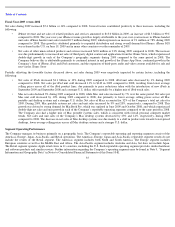Apple 2010 Annual Report Download - page 34
Download and view the complete annual report
Please find page 34 of the 2010 Apple annual report below. You can navigate through the pages in the report by either clicking on the pages listed below, or by using the keyword search tool below to find specific information within the annual report.
Table of Contents
The Company records accruals for estimated cancellation fees related to component orders that have been cancelled or are expected to be
cancelled. Consistent with industry practice, the Company acquires components through a combination of purchase orders, supplier contracts,
and open orders based on projected demand information. These commitments typically cover the Company’
s requirements for periods ranging
from 30 to 150 days. If there is an abrupt and substantial decline in demand for one or more of the Company’
s products or an unanticipated
change in technological requirements for any of the Company’
s products, the Company may be required to record additional accruals for
cancellation fees that would negatively affect its results of operations in the period when the cancellation fees are identified and recorded.
Warranty Costs
The Company provides for the estimated cost of hardware and software warranties at the time the related revenue is recognized based on
historical and projected warranty claim rates, historical and projected cost-per-
claim, and knowledge of specific product failures that are outside
of the Company’
s typical experience. Each quarter, the Company reevaluates its estimates to assess the adequacy of its recorded warranty
liabilities considering the size of the installed base of products subject to warranty protection and adjusts the amounts as necessary. If actual
product failure rates or repair costs differ from estimates, revisions to the estimated warranty liability would be required and could materially
affect the Company’s results of operations.
The Company periodically provides updates to its applications and operating system software to maintain the software’
s compliance with
specifications. The estimated cost to develop such updates is accounted for as warranty cost that is recognized at the time related software
revenue is recognized. Factors considered in determining appropriate accruals related to such updates include the number of units delivered, the
number of updates expected to occur, and the historical cost and estimated future cost of the resources necessary to develop these updates.
Income Taxes
The Company records a tax provision for the anticipated tax consequences of the reported results of operations. In accordance with GAAP, the
provision for income taxes is computed using the asset and liability method, under which deferred tax assets and liabilities are recognized for the
expected future tax consequences of temporary differences between the financial reporting and tax bases of assets and liabilities, and for
operating losses and tax credit carryforwards. Deferred tax assets and liabilities are measured using the currently enacted tax rates that apply to
taxable income in effect for the years in which those tax assets are expected to be realized or settled. The Company records a valuation
allowance to reduce deferred tax assets to the amount that is believed more likely than not to be realized.
The Company only recognizes the tax benefit from an uncertain tax position if it is more likely than not that the tax position will be sustained on
examination by the taxing authorities, based on the technical merits of the position. The tax benefits recognized in the financial statements from
such positions are then measured based on the largest benefit that has a greater than 50% likelihood of being realized upon ultimate settlement.
Management believes it is more likely than not that forecasted income, including income that may be generated as a result of certain tax planning
strategies, together with future reversals of existing taxable temporary differences, will be sufficient to fully recover the deferred tax assets. In
the event that the Company determines all or part of the net deferred tax assets are not realizable in the future, the Company will make an
adjustment to the valuation allowance that would be charged to earnings in the period such determination is made. In addition, the calculation of
tax liabilities involves significant judgment in estimating the impact of uncertainties in the application of GAAP and complex tax laws.
Resolution of these uncertainties in a manner inconsistent with management’s expectations could have a material impact on the Company’
s
financial condition and operating results.
31
























